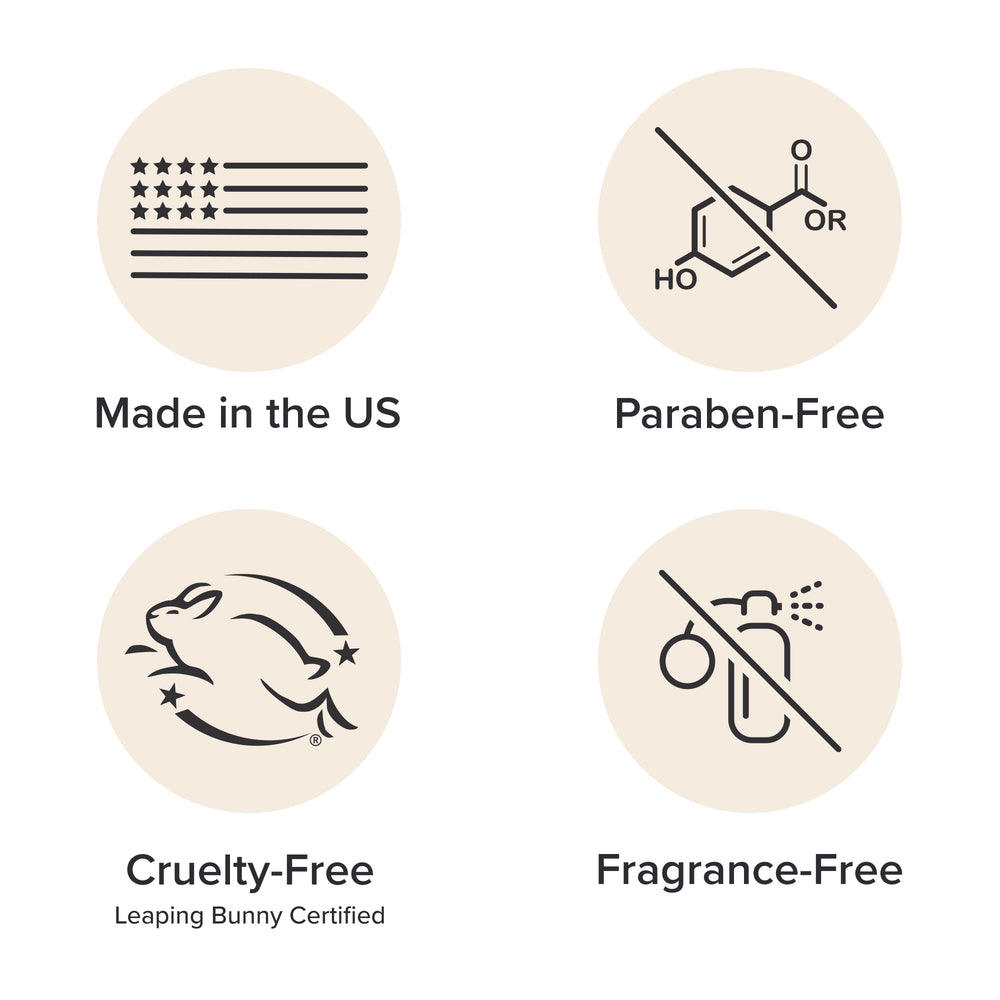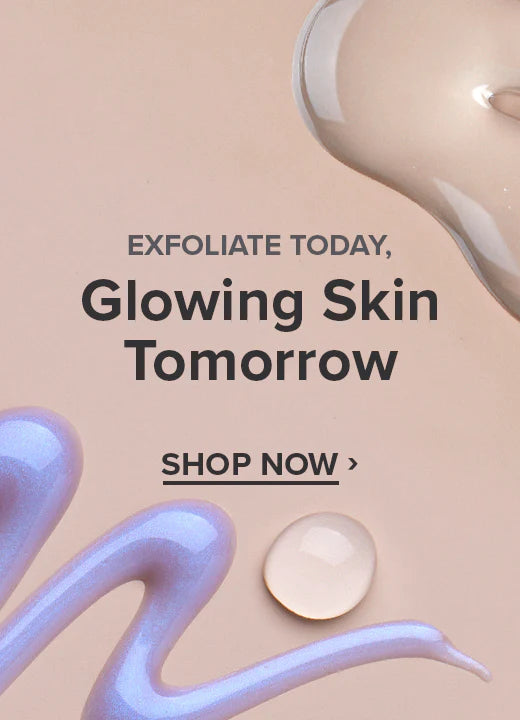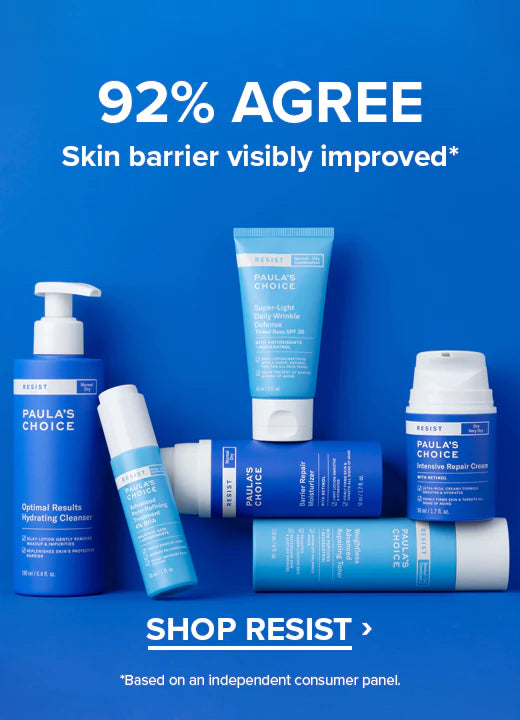Written by: Shannon Steck
Medically Reviewed by: Beth McLellan MD Board-Certified Dermatologist
Skin purging is a phenomenon that some people with breakout-prone skin experience after using a leave-on exfoliant or certain other active ingredients for the first time. The theory is that such products “purge” the skin from clogs that form and get stuck deep in the pore, pushing them quickly to the surface. Seemingly overnight after adding a new product or ingredient into your skin care routine, those experiencing skin purging see a fresh crop of breakout-like dots and bumps across the skin. Eventually, the purging tapers off and you see results from the product.
Some chalk this up as their skin getting worse before it gets better, but what’s really going on? Let’s explore everything you need to know about skin purging.
What causes skin purging?
Skin purging can be caused by using a chemical exfoliant that loosens the gunk in the pore and speeds cell turnover, thus bringing the clog in the pore to the surface faster. A similar effect can happen with other treatments such as retinoids, like retinol, that may cause purging due to the way they impact how skin cells move from the lower layers to the surface (1, 2).
Salicylic acid (also known as BHA) is the chemical exfoliant most associated with this phenomenon because its oil-soluble nature lets it penetrate pores, breaking apart clumps of skin cells trapped in the pore lining. It also thins the thick, sticky oil (sebum) buildup that occurs inside pores to reduce the size of clogs residing deeper in skin. Salicylic acid also improves the shape of the pore lining and once the pore is normalized, the backed-up, smaller clog can more easily come to the surface, appearing as new clogged pores (blackheads or white bumps).
Most of these clogs would eventually make their way to the surface as open comedones (blackheads) or closed comedones (whiteheads), both known as non-inflammatory acne. Left untreated, these comedones can lead to more inflamed acne bumps, but worry not: using a product like a BHA exfoliant has the potential to speed up the process and eliminate the clogs that eventually lead to acne. With continued use, BHA steadily eliminates the clogged bumps and helps clear the skin (3).
We also urge you to keep in mind that what you see may not actually be skin purging. Sometimes you just happen to start a new product at the same time you would have been going through a new bout of breakouts. This is especially true for those who start using new products around the time of their menstrual cycle when breakouts are more common (4).
Is skin purging good?
Although worrisome for someone who doesn’t know what it is, skin purging is simply a sign that the chemical exfoliant or retinoids you added to your routine are working the way they should.
Skin purging is a visual representation of the way in which these ingredients interact with the cell turnover process, nothing more or less!
What does skin purging look like?
Skin purging is strikingly similar in appearance to non-purge related breakouts and bumps that appear regularly on skin. That’s because it’s these same clogs coming to the surface, just in an accelerated manner. Due to this, skin purging will visually consist of red bumps and breakouts dotted along where you’ve applied the chemical exfoliant or retinoid product to your skin. “This type of flare usually is made up of comedones – black heads or white heads that appear after starting a new product,” according to board-certified dermatologist Dr. Beth McLellan.
Sometimes, those experiencing skin purging will fail to notice it because of this resemblance. However, for some, skin purging also constitutes redness or a bit of dryness. Remedy this with the use of a moisturizer rich in ceramides, hyaluronic acid and other skin-replenishing ingredients (5).
How to tell the difference between skin purging and breakouts?
The easiest way to tell the difference between skin purging and routine breakouts is by the timing. The comedones triggered through skin purging only happen at the beginning of using a product capable of causing purging. On the other hand, breakouts caused by garden variety acne shouldn’t worsen when starting a product known to improve acne, whether over-the-counter or prescription.
If you’ve recently begun using a chemical exfoliant or retinoid, it’s likely that what you’re experiencing is purging, not a breakout. But admittedly it can be hard to tell for those who always have some degree of breakouts.
Dr. Beth McLellan recommends sticking with a product that is known to cause purging but not breakouts, such as a leave-on exfoliant that contains 1–2% salicylic acid. Over time, the blackheads and bumps should improve. If they don’t you may need to add prescription or over-the-counter acne products to your regimen (6).

Does skin purging have to happen?
Skin purging doesn’t have to happen to everyone. The saying that “your skin has to get worse before it gets better” isn’t universally true. Why purging happens to some people and not others remains a mystery, just like how some people experience comedones but not the red, swollen pimples and papules characteristic of inflammatory acne.
If you experience purging the first time you use retinol or a leave-on exfoliant, it can be tempting to stop using the product immediately. We encourage you to stick it out for a couple of weeks to get through this phase. Otherwise, you’ll be losing out on all the wonderful benefits these kinds of impactful formulations can provide.
More to the point, what you might see on skin’s surface likely would’ve shown up eventually, or simply would’ve remained deep in the pore, keeping it clogged and enlarged, possibly becoming severe acne. It’s good to see all this movement to the surface, despite the initial distress it causes.
How long does skin purging last?
Skin purging is temporary! Since it occurs as a result of cell turnover and movement of deeper clogs to the surface, purging should last for about one complete skin cycle, which is about 28-40 days or four to six weeks. Dr. McLellan always encourages trying ingredients known to cause purging for at least six weeks to see whether they will be effective. “I explain to my patients that these ingredients work best by preventing new pimples from forming not from making existing acne lesions go away faster – seeing the benefit takes time.”
During this time, it’s important to remember to be patient. Afterall, this stimulated cell turnover will bring about smooth, radiant benefits.
How to speed up skin purging?
There’s no way to speed up skin purging once it begins, but there are ways to not prolong this period:
- Don’t incorporate more ingredients that cause purging into your routine
- Treat skin with care, moisturizing appropriately with skin-replenishing ingredients
- Avoid picking at any comedones that appear
- Protect skin from the sun and apply a broad-spectrum sunscreen with an SPF 30+ daily
- Skip out on professional chemical peels or laser treatments while experiencing skin purging, this can cause irritation
What if I’m still breaking out more than usual?
If you’re still breaking out more than usual a couple of weeks after the initial “purge,” consider what else you're using in your routine. Your breakout may be worsening due to other factors like hormones, medications, or just as a natural progression. If your skin isn’t improving as much as you’d like, Dr. McLellan recommends you seek help from a board-certified dermatologist to review your regimen and possibly add prescription-strength medications.
That said, for some people it simply comes down to their skin not responding well to certain ingredients, which may result in an unwanted reaction to skin care products (known as irritant contact dermatitis). If your skin doesn’t seem to be getting through the adjustment period, you may need to quit using the product in question altogether and seek out alternatives.
References for this information:
- Dermatologic Therapy, September 2017, pages 293-304
- Postepy Dermatologii I Alergologii, August 2019, pages 392-397
- Clinical, Cosmetic, and Investigational Dermatology, August 2015, pages 455-461
- The Journal of Clinical and Aesthetic Dermatology, January 2017, pages 37-46
- Journal of Cosmetic Dermatology, March 2020, pages 660-670
- Journal of Italian Dermatology and Venereology, December 2020, pages 744–748






